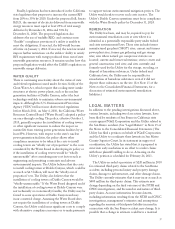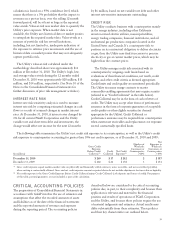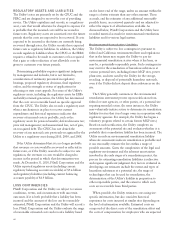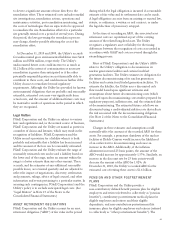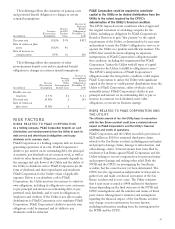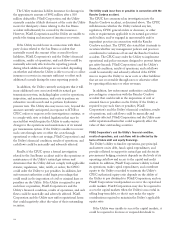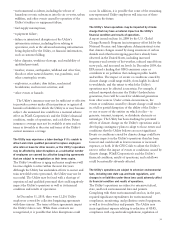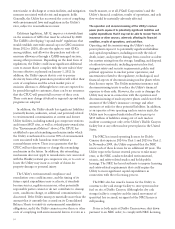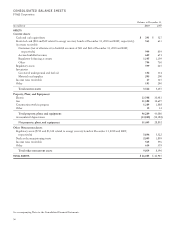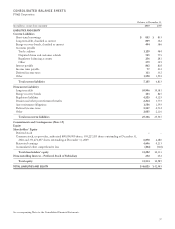PG&E 2010 Annual Report Download - page 51
Download and view the complete annual report
Please find page 51 of the 2010 PG&E annual report below. You can navigate through the pages in the report by either clicking on the pages listed below, or by using the keyword search tool below to find specific information within the annual report.the terms of the Chapter 11 settlement agreement and the
Utility’s plan of reorganization in a manner that would
produce the economic results that PG&E Corporation and
the Utility intend or anticipate.
The Utility’s failure to recover any material amount of
its costs through its rates in a timely manner would have a
material adverse effect on PG&E Corporation’s and the
Utility’s financial condition, results of operations, and cash
flows.
The Utility faces uncertainties associated with the future level
of bundled electric load forwhich it must procure electricity
and securegenerating capacity and, undercertain
circumstances, may not be able to recoverall of its costs.
The Utility must procure electricity to meet customer
demand, plus applicable reserve margins not satisfied from
the Utility’s own generation facilities and existing
electricity contracts. When customer demand exceeds the
amount of electricity that can be economically produced
from the Utility’s own generation facilities plus net energy
purchase contracts (including DWR contracts allocated to
the Utility’s customers), the Utility will be in a “short”
position. When the Utility’s supply of electricity from its
own generation resources plus net energy purchase
contracts exceeds customer demand, the Utility is in a
“long” position.
The amount of electricity the Utility needs to meet the
demands of customers that is not satisfied from the
Utility’s own generation facilities, existing purchase
contracts, or DWR contracts allocated to the Utility’s
customers could increase or decrease due to a variety of
factors, including, without limitation, a change in the
number of the Utility’s customers; periodic expirations or
terminations of the Utility’s existing electricity purchase
contracts; termination of the DWR’s obligations to provide
electricity under purchase contracts allocated to the
Utility’s customers; execution of new energy and capacity
purchase contracts; fluctuation in the output of
hydroelectric and other renewable power facilities owned
or under contract by the Utility; implementation of new
energy efficiency and demand response programs; and the
acquisition, retirement, or closure of generation facilities.
The amount of electricity the Utility would need to
purchase would immediately increase if there were an
unexpected outage at Diablo Canyon or any of its other
significant generation facilities. In addition, as the
electricity supplier of last resort, the amount of electricity
the Utility would need to purchase also would immediately
increase if a material number of customers who purchase
electricity from alternate energy providers (referred to as
“direct access” customers) or customers of community
choice aggregators (see below) decided to return to
receiving bundled services from the Utility. If the Utility’s
short position unexpectedly increases, the Utility would
need to purchase electricity in the wholesale market under
contracts priced at the time of execution or, if made in the
spot market, at the then-current market price of wholesale
electricity. The CPUC could disallow some or all of the
costs incurred to purchase electricity under such
circumstances if the CPUC determined that the Utility
acted imprudently or if the CPUC found that the prices or
terms of the Utility’s purchases of electricity were not
reasonable. The Utility’s inability to recover its costs could
have a material adverse effect on the financial condition,
results of operations, or cash flows of the Utility and PG&E
Corporation.
Alternatively, the Utility would be in a long position if
the number of Utility customers declined because of a
general economic downturn in the Utility’s service
territory, or if a greater number of customers became
customers of direct access providers or community choice
aggregators. California law permits California cities and
counties that have registered as community choice
aggregators to purchase and sell electricity for their
residents and businesses. The Utility would continue to
provide distribution, metering, and billing services to the
community choice aggregators’ customers, and would be
those customers’ electricity provider of last resort. In
addition, the Utility could lose customers through
municipalization, the exercise of eminent domain power by
municipalities to acquire and operate the Utility’s facilities,
which are then used to provide utility service to the
municipality’s residents.
In addition, the Utility could lose customers, or
experience lesser demand, because of increased customer
self-generation. The risk of the loss of customers and
decreased demand through self-generation is increasing as
the CPUC has approved various programs to provide self-
generation incentives and subsidies to customers to
encourage development and use of renewable and
distributed generating technologies, such as solar
technology. The number of the Utility’s customers also
could decline due to stricter GHG regulations or other
state regulations that cause customers to leave the Utility’s
service territory.
If the Utility were in a long position, the Utility would
be required to sell the excess electricity purchased from
third parties under electricity purchase contracts, possibly
at a loss. In addition, excess electricity generated by the
Utility’s own generation facilities may also have to be sold,
possibly at a loss, and costs that the Utility may have
incurred to develop or acquire new generation resources
may become stranded.
47


